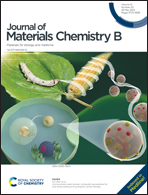EGCG-crosslinked carboxymethyl chitosan-based hydrogels with inherent desired functions for full-thickness skin wound healing†
Abstract
Hydrogel wound dressings have attracted intense and increasing interest for their extracellular matrix like properties and bioactive material delivery ability. Various functional hydrogels loaded with metals (and their oxides), antibiotics and anti-inflammatory agents have been prepared to realize antioxidant, bactericidal and anti-inflammatory effects, accelerating wound healing. Nevertheless, it is still a big challenge to facilely fabricate hydrogel wound dressings with inherent desirable properties to promote wound healing and avoid some drawbacks such as toxicity of metals and drug resistance. Herein, we facilely prepared a series of (−)-epigallocatechin-3-O-gallate (EGCG)-crosslinked carboxymethyl chitosan-based hydrogels (EP gels) with inherent antioxidant, bactericidal and adhesive properties. Gluconate-terminated polyethylene glycol (PEG-glu) was introduced into gel networks to enhance the mechanical properties. The hydrogels are constructed via borate ester crosslinking between phenylboronic acid (PBA) groups of PBA-grafted carboxymethyl chitosan (CMCS-PBA) and diol groups of EGCG and PEG-glu. The hydrogels exhibited excellent self-healing properties, desirable mechanical and adhesive strength, free radical scavenging capability and outstanding bactericidal ability against S. aureus and E. coli. In the subsequent full-thickness skin defect model of mice, EP1 gel could promote the proliferation and remodeling process such as the regeneration of epidermis, dermis, and skin appendages, deposition of collagen, and upregulation of the VEGF level, thereby accelerating the healing of damaged skin. Overall, we facilely prepared polysaccharide-based hydrogels with inherent desirable properties as promising dressings for wound repair.



 Please wait while we load your content...
Please wait while we load your content...